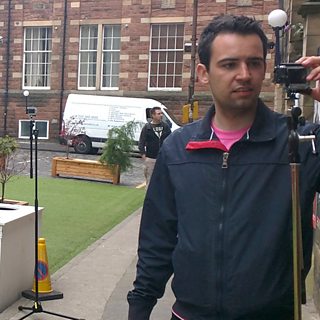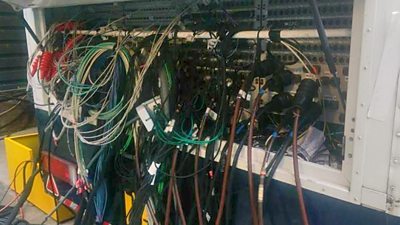
The flexibility of using IT industry standard IP networks as the basis for broadcast infrastructure opens up exciting opportunities for new types of content and experiences. BBC R&D has already demonstrated what this technology may allow us to do in the future with projects like CAKE (the Cook Along Kitchen Experience), Nearly Live and Forecaster. Alongside this our IP Studio team are working with our partners in the AMWA group to the Network Media Open Standards (NMOS) that will allow broadcast manufacturers to produce interoperable IP broadcast equipment and software.
Who knew making a TV program took this many wires!
BBC Northern Ireland are interested in establishing a proof of concept lab, so they can investigate the current state of the technology, and evaluate hardware and software from different manufacturers. This is intended to allow BBC Northern Ireland to reap the benefits of IP based broadcasting, and offer new experiences to their audiences. During my traineeship for BBC R&D I spent time with our IP Studio team and when it ended I took on a three month mini-placement with our colleagues in Belfast to share with them some of the experiences I had with the technology.
For many years BBC Northern Ireland have held a reputation for using innovative technical solutions and for embracing new technology. The new lab is intended to facilitate practical investigations into how IP technology might fit into their existing workflows. One of the first tasks on my placement was to spend time working closely with production teams and draw up a diagram showing the basic design of the lab's network and to test sending video and audio across it - to be approved by managers at BBC NI.
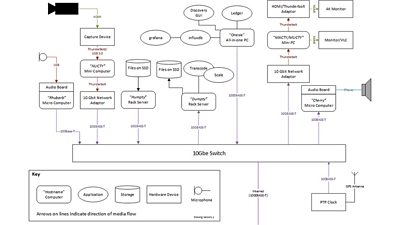
Initial design for the lab. It grew a lot during the project!
Video would be provided by a 4K camera, and could be sent over the network to a UHD monitor. To test live audio a microphone was connected to a credit-card sized micro-computer fitted with an audio card, and then streamed to a similar device with a speaker attached. Notice how - apart from the capture and playback devices - all the devices in the system are generic IT hardware. This is a big difference from the very domain specific equipment that the broadcast industry currently uses throughout the entire broadcast chain.
One of the requirements for the lab was to be able to transport UHD resolution video un-compressed across the network. The data rates involved in this are extremely high, and required the lab to be fitted with a 10Gb/s network and switch to be able to handle the traffic load. We soon found that the network switch we had initially employed - a fairly inexpensive small business switch - while it technically supported 10Gb/s very quickly flooded when presented with that much traffic for longer periods. Often we had a choice between running trials or having access to the internet!The lab was designed to transport audio and video using the NMOS specifications for identity and timing. These require that each frame of video and each sample of audio must be individually time-stamped and identified, allowing video and audio to be tracked through the broadcast chain. This allows multiple video and audio sources to be transported across the network separately and synchronised at the other end. Additionally the lab uses NMOS discovery and registration, allowing every video and audio device on the network to discover each-other, making the process of routing audio and video around the network far easier than solutions requiring manual entry of IP addresses.
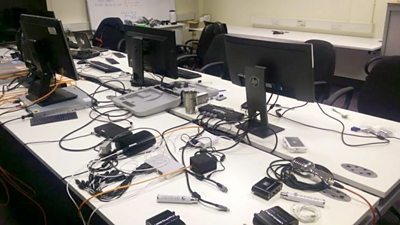
Early days in the lab - note the large amounts of IT equipment!
- BBC R&D - Discovery and Registration in IP Studio
- BBC R&D - IP Studio Update: Partners and Video Production in the Cloud
The lab makes extensive use of the open source software Dynamorse, which implements these NMOS specifications. Dynamorse is based on a piece of software called Node-RED, which was originally intended for use in internet of things applications, however its user interface based around connecting blocks together to form complex systems is used by Dynamorse to allow the user to build up chains of processing on devices in the network.As well as working to help establish the lab I also got the opportunity to spend some time working with the many production teams making programmes in BBC Northern Ireland. While BBC R&D works closely with colleagues in production it is still relatively unusual to have an opportunity to be involved in a program as it is going out live. I was able to spend time with the productions teams of Newsline (Northern Ireland national news), The Stephen Nolan Show (a current affairs program broadcast in NI) and even the Children in Need outside broadcast live from the Titanic museum in Belfast.
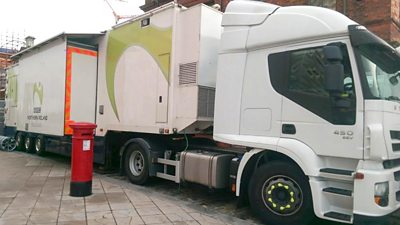
BBC Northern Ireland outside broadcast truck working on BBC Children in Need
As well as being a tremendously exciting opportunity to go behind the scenes on some of BBC Northern Irelands biggest productions, it was an important opportunity to look for ways that the work being done in R&D can make an impact on the work of BBC Northern Ireland. One example that grabbed my attention is shown at the top of this article. It is a picture of the "tail board" of BBC Northern Ireland's outside broadcast truck, where all the cables for cameras, communications and sound are connected into the truck. As you can see there are a vast number of cables, all of which must be un-plugged and re-plugged every time the truck is moved! Introducing IP networking to broadcasting could dramatically simplify this type of connecting up - instead of all these connections imagine just having to connect a couple of fibre optic cables!There are lots of other experiences and work from my time in Northern Ireland from working with the project management teams working on other new technologies in Northern Ireland to helping the technical teams who keep the edit suites running smoothly. With my colleagues in Northern Ireland we were able to establish a working test facility for IP broadcast technology, which will serve as a test bed for this new technology as it matures. My time with BBC Northern Ireland flew past, and before I knew it, it was time to return to the lab in Salford. However I learned a huge amount, and I will always have some very fond memories of my time there!
- Tweet This - Share on Facebook
- BBC R&D - High Speed Networking: Open Sourcing our Kernel Bypass Work
- BBC R&D - Beyond Streams and Files - Storing Frames in the Cloud
- BBC R&D - IP Studio
- BBC R&D - IP Studio: Lightweight Live
- BBC R&D - IP Studio: 2017 in Review - 2016 in Review
- BBC R&D - IP Studio Update: Partners and Video Production in the Cloud
- BBC R&D - Running an IP Studio
- BBC R&D - Building a Live Television Video Mixing Application for the Browser
- BBC R&D - Discovery and Registration in IP Studio
- BBC R&D - Media Synchronisation in the IP Studio
- AMWA - Advanced Media Workflow Association
- BBC R&D - Industry Workshop on Professional Networked Media
- NMOS - Networked Media Open Specifications
- BBC R&D - The IP Studio
- BBC R&D - IP Studio at the UK Network Operators Forum
- BBC R&D - Industry Workshop on Professional Networked Media
- BBC R&D - Covering the Glasgow 2014 Commonwealth Games using IP Studio
- BBC R&D - Investigating the IP future for BBC Northern Ireland
